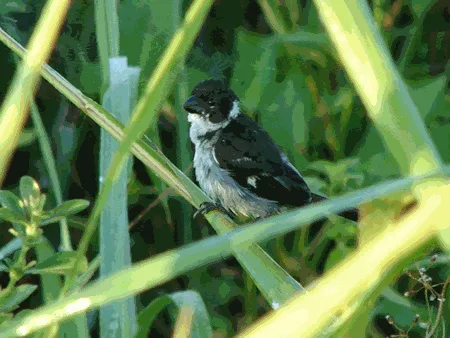
Wing-barred Seedeater
[order] PASSERIFORMES | [family] Thraupidae | [latin] Sporophila americana | [UK] Wing-barred Seedeater | [FR] Sporophile variable | [DE] Wechselpfaffchen | [ES] Espiguero Chocoano | [NL] Bont Dikbekje
Subspecies
| Genus | Species | subspecies | Breeding Range | Breeding Range 2 | Non Breeding Range |
| Sporophila | americana | SA | n, w Amazonia | ||
| Sporophila | americana | americana | |||
| Sporophila | americana | dispar |
Physical charateristics
Adult males have a relatively heavy black bill. The upperparts are black, except for a greyish rump (actually white finely streaked black, but only visible up-close) and two distinct white wing-bars (the lower often reduced). The underparts are white, except for a broad black pectoral collar (sometimes reduced and incomplete) and blackish mottling to the upper flanks. The far duller female has a brownish bill, dull buffy-olive upperparts and pale olive-ochre underparts. Juveniles resemble adult females.
| wingspan min.: | 0 | cm | wingspan max.: | 0 | cm |
| size min.: | 11 | cm | size max.: | 12 | cm |
| incubation min.: | 12 | days | incubation max.: | 14 | days |
| fledging min.: | 0 | days | fledging max.: | 14 | days |
| broods: | 1 | eggs min.: | 2 | ||
| eggs max.: | 3 |
Range
South America : North, West Amazonia
Habitat
It is common in grassy and bushy areas, such as scrubby fields, agricultural areas, roadsides and cities. This seedeater is a common to abundant bird in lowlands and foothills up to 1,500 m altitude in semi-open areas such as forest edges, roadsides, low scrub and gardens. It also flocks with other species of seedeaters in pasture, weedy fields and other grassland.
Reproduction
The flimsy cup nest, built by the female, is made of coarse plant material and lined with a few finer fibres. It is placed in a tree 0.4 to 6 m up, occasionally higher, in the fork of a twig. The clutch is two or three brown-speckled pale grey eggs, which are incubated by the female alone for 12?14 days to hatching.
Feeding habits
This species, living in snall flocks or pairs, feeds mainly on grass seeds, but also takes other seeds, berries and some insects.
Conservation
This species has an extremely large range, and hence does not approach the thresholds for Vulnerable under the range size criterion (Extent of Occurrence <20,000 km2 combined with a declining or fluctuating range size, habitat extent/quality, or population size and a small number of locations or severe fragmentation). The population trend appears to be stable, and hence the species does not approach the thresholds for Vulnerable under the population trend criterion (>30% decline over ten years or three generations). The population size is very large, and hence does not approach the thresholds for Vulnerable under the population size criterion (<10,000 mature individuals with a continuing decline estimated to be >10% in ten years or three generations, or with a specified population structure). For these reasons the species is evaluated as Least Concern.

Migration
Sedentary throughout range
Distribution map

